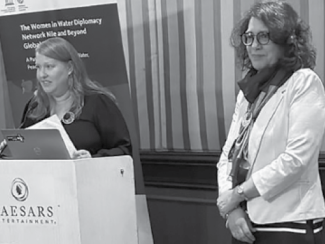When the once-secure American railroad industry went through its grinding economic contraction in the 20th century, a notable casualty was the dense lattice of rail corridors that once connected virtually every city, town, hamlet, mine, and forest. Beginning in 1916, the system shrank from 254,000 miles to about 137,000 today. Many of those potentially useful rights of way were plowed under or otherwise lost forever, but thousands of others were saved by plucky activists or farsighted government agencies for non-motorized trails, utility corridors, and other public purposes.
Interestingly, the conversion of abandoned rail lines to trails wasn’t a Great Society-type program that came out of a mandate from Washington, D.C. It was a from-the-grassroots movement that bubbled up in the 1960s in several small midwestern places. But, within a few years of the creation of the earliest trails, the rise of some thorny political and legal issues — not to mention some exciting opportunities — elevated the issue to national prominence and caught the attention of Capitol Hill and the executive branch.
Federal agencies and ultimately Congress were pulled into the fray. Most relevant was the Interstate Commerce Commission, which had been dealing with abandonments for decades, but only in the context of a binary conflict between railroads and shippers. The idea of a “third way” — post-abandonment trails — was a new knuckleball that the commission was less than excited to take a swing at. Now, suddenly there was pressure from local communities and citizens organizations to slow down the process to afford them more time so that they could frantically gear up to rescue a line for a trail.
The other federal agency that perked up its ears to the faint sound of rail-trails coming was the Department of the Interior, specifically its small and obscure Bureau of Outdoor Recreation, a unit that had been created in 1962 by Secretary Stewart Udall to fill the space between the highly preservation-oriented National Park Service and the sports-and-crafts bent of local park departments. With a motivated and entrepreneurial staff, the bureau had developed a culture of activism, doing outreach into low-income communities that were often political tinderboxes partly because of a lack of outdoor places to exercise. Rail-trails, which were national in scope but not “natural” enough to pass muster with the National Park Service, were a perfect fit for the bureau, and in 1971 it published a visionary booklet called “Establishing Trails on Rights-of-Way.” Among other things, the publication exhorted activism and even noted the specific locations of hundreds of railroad corridors that had been abandoned between 1960 and 1970.
Meanwhile, two unrelated tides were rising on Capitol Hill. One aimed to solve the railroads’ economic problems, while the other sought to address the public’s demand for more trails. If joined together, they would make waves. Ironically, when it finally happened, the railroad law yielded a surprise trails program, and the trail act broke new ground in railroad practice.
First up was the railroad bill. By the time the Penn Central went bankrupt in 1970, the tightly regulated U.S. railroad industry was so deeply mired in crisis that Congress needed 11 years and five different laws to devise a way out. One of many sticky questions was whether railroads would be allowed to abandon money-losing routes and, if so, how. In 1975, when a Senate subcommittee held 15 days of hearings on the topic, virtually everyone who testified shared one of two opposing concerns — keeping the lines open for the benefit of shippers and communities, or sloughing off uneconomical routes for the benefit of railroads and their stockholders. But one subcommittee staff member, Tom Allison, had something else on his mind.
Allison, a young Seattle lawyer, was a strong runner (“he would cut back to quarter-speed so that I could keep up with him,” recalled one of his colleagues), he loved trains (“actually, he loved everything that went fast,” his wife later reminisced), and he was a clever tactician (“I have yet to find anyone who had his overarching understanding of the role of railroads,” reminisced another committee colleague, and he “was driven by notions of the good things that government can do.”). During his law school years at the University of Washington, Allison had closely followed a local controversy over the 1971 abandonment of a train track through the university’s grounds. The fledgling effort to save it as the Burke-Gilman running and biking trail may have had particular resonance for him since he had suffered leg damage in a bicycle accident while in school.
When Allison passed the Washington state bar, he had the honor of being sworn in by the Supreme Court’s pro-conservation justice, William O. Douglas, and then landed a clerkship with Senator Warren Magnuson (D-WA), chairman of the Senate Commerce Committee. In D.C., in his free time, Allison ran on the C&O Canal towpath (which had been saved and recently turned into a national park partly through the help of Justice Douglas). While running, Allison undoubtedly spotted the adjacent, little-used Georgetown Branch rail line, and he was probably also aware of efforts in nearby Virginia to create a trail out of the abandoned W&OD Railroad. He started wondering whether he could use politics to combine his instincts for railroad preservation with his interests in recreation and nature conservation. Fortunately, at work, he had been promoted to counsel for the subcommittee on surface transportation.
What Allison envisioned was the preservation of abandoned rail corridors. He may or may not have known about the many legal complexities that surround the ownership of the corridors, but, with Magnuson’s blessing, he took to Senator Vance Hartke (D-IN) the concept of a program for developing railroad rights-of-way as car-free transportation routes. In June 1975, Senators Hartke and Magnuson cosponsored the Conversion of Abandoned Rights-of-Way Act. The bill called for the identification of railroad rights-of-way without rail service (or where it was likely soon to terminate) and which were potentially suitable for biking or walking. It authorized $25 million for the Departments of Transportation and Interior to provide technical and financial assistance for the conversions. The concept was approved and folded as Section 809(b) into the much larger Railroad Revitalization and Regulatory Reform bill.
Every bill goes through markup — backroom discussion by the senators — before passage. For the 4R Act the principal participants were Hartke, Lowell Weicker (R-CT), James Buckley (R-NY) and Howard Baker (R-TN). Although markup sessions are initially private, after 30 years the record is unsealed. The conversation on Section 809(b), as revealed from the National Archives, was very brief:
Hartke: “Should states be assisted in the acquisition of abandoned rights-of-way for conversion to recreational uses? I think they ought to preserve them for bicycle paths and things of that sort.”
Buckley: “How much money is involved?”
Hartke: “$25 million. I think in a lot of cases they ought to have acquired these rights-of-way anyway. All right. Is there any objection to that provision?”
(No response.)
After passage by the committee, the full $7.6-billion 4R Act passed the Senate in December.
Two weeks later, the House of Representatives enacted similar legislation. It included a provision to set up a smaller, $5-million rails-to-trails program within the Transportation Department.
Since the House and Senate bills were not identical, a conference committee was set up to iron out the differences and bring the two bills into alignment. That committee accepted the more generous Senate rails-to-trails funding.
However, before the final vote, the Ford administration announced that the spending level was too high and threatened a veto. In response, the conferees returned for intensive negotiations with the White House. The three-year rails-to-trails program was reduced but it survived. President Ford signed the Railroad Revitalization and Regulatory Reform Act in February 1976. Thanks to Tom Allison, the United States finally had a national rails-to-trails program.
In reflecting on Allison’s work, his colleague Sallie Adams said, “Tom was able to keep the micro, the macro, and the public interest all in alignment.” He had done that with this program — a small strategy that, if it could prove itself, held the seeds for something much bigger. Sadly, while Allison had a very successful legal career, his behind-the-scenes role in the rails-to-trails movement wasn’t recognized during his lifetime. He died in 2012 with his achievement unheralded.
Meanwhile, an even more remarkable story was starting to play out in the other chamber of the Capitol, on the “trail side” of the coin.
When it came to footpaths, Congress had never shown much interest. It had created the 1968 National Trails System Act, but in comparison to canals, railroads, and roads, trails received little funding. To the limited extent that trails ever received support, it was always at the state or local level, and usually through private donations or volunteer labor.
Even the 1968 law, passed with great anticipation, was disappointing to its backers. Eight years after passage, so little had occurred on the ground that frustrated conservationists prevailed upon Representative Roy Taylor (D-NC) to schedule an oversight hearing. The testimony revealed that, in a typical Washington scenario, money had been authorized by Congress but then hadn’t been obligated by the Nixon and Ford administrations. It was like being told to go shopping with an empty wallet.
“In his gentlemanly way, Taylor pinned their asses to the wall,” recalled Cleve Pinnix, the committee staffer who set up the hearing. He was describing the predicament of the bureaucrats who came up to testify. The record clearly showed that significant trail money was badly needed. When the elderly Taylor retired soon thereafter, he was succeeded by a remarkable labor lawyer, a congressional bulldog from San Francisco named Phil Burton (D-CA).
Although parks were not Burton’s top passion, his primary interest in justice for the poor and downtrodden made him see parks as refuges for the less fortunate. As a San Franciscan, he also had a particular interest in preserving the redwoods and saving the green spaces around the Golden Gate Bridge.
Burton had staffer Cleve Pinnix do much of the policy work while he did the political horse trading. The first outcome of the collaboration was the breathtakingly vast National Parks and Recreation Act. (Memorably, when the $1.4-billion bill cleared a committee hurdle in only five minutes, a conservative congressman said, “Notice how quiet we are. We all got something in there.”) Passed in 1978, it still stands as the largest park bill ever voted by Congress.
The following year Burton picked up where he had left off. Since seven trail bills had failed to make it into the previous bill, the congressman and Pinnix pulled those concepts together as the nucleus of new legislation to amend the National Trails System Act. The bill mostly focused on the nitty-gritty needs of particular trails, but one section was different. It was lofty and non-specific:
“The secretary of transportation, in administering the Federal Aid Program, together with chairman of the Interstate Commerce Commission and the secretary of the interior, in administering the Railroad Revitalization and Regulatory Reform Act of 1976, shall encourage state and local agencies and private interests to establish such trails using the provisions of such programs.”
The bill passed the House on September 22. The vague “such trails” clause was simply referred to as one of “numerous technical and clarifying amendments.” During the House floor debate, it wasn’t even mentioned. The Senate also passed it, but time ran out before the bills could be resolved, and the measure died with the end of the session.
Burton planned to immediately reintroduce his amendments in the next Congress, but then came the political earthquake of the 1980 election. Not only was President Jimmy Carter defeated by Ronald Reagan, but the Democrats also lost their majority in the Senate as well as multiple seats in the House. Because of the precarious new politics, Burton asked his staff and allies to take the bill around to all the remaining senators and to members of the bureaucracy to make sure that no one had any problems with it. One of the young allies who literally walked the bill around the halls of the Interior Department was Craig Evans, the new director of the American Hiking Society. Normally, Evans recalled, when he spent time at the sprawling Interior Department, it was in the sixth corridor, at the Na-tional Park Service, but this time Burton specifically told him to go to a different corridor and show the bill to a young lawyer from Long Island named Pete Raynor.
Although Raynor had been working at a large New York law firm, he soon decided that he wanted to work for the public good, settled for a lower salary, and landed a job in the solicitor’s office at Interior. There, he cut his environmental teeth on a lawsuit over the newly established Redwoods National Park. Through that work he connected with Burton, who asked him to help draft legislation to enlarge the park.
“Burton was a brilliant, omnivorous, larger-than-life character with a steel trap mind,” recalls Raynor. “Anything he read, he never forgot. If you wrote him a memo, he could recall it better than you could. He remembered the exact wording of early drafts that had long been discarded. Plus, he was aggressive and fearless. He rose late, rarely got to the committee room before 4 p.m. and then worked past midnight. I would go over there in the evening and we’d kick around ideas for hours. I was mesmerized.” They wrote a redwoods bill together and Burton saw that it got passed in 1978.
Raynor, like Tom Allison, was a runner on the C&O Canal, which headed in the direction of his home in suburban Maryland. He too soon noticed the lightly-used Georgetown Branch railroad track which paralleled the towpath before curving off into the woods. “I thought, wouldn’t it be cool if instead of having my wife drive to pick me up from the Canal, I could run on the tracks, which would take me almost right home.” But, as a lawyer, he also realized that if the railroad ever stopped running, the easements underlying the track might likely disappear, breaking the corridor into useless individual parcels.
One of Raynor’s friends and mentors at the National Park Service was Chuck Rinaldi, the man in charge of land acquisition for the Appalachian Trail. At the time, the AT was painfully discontinuous, with many on-road sections substituting for proper natural trail routes. Rinaldi was an aggressive, skillful negotiator and land purchaser, and one of his mantras was, “Don’t buy easements.” In contrast, he pioneered a counter-intuitive approach of buying land with full title, then turning around and offering easements for things like cattle grazing, a second home, or a farm-road crossing. Spending time with Rinaldi gave Raynor a good opportunity to learn about the many problems and challenges that easements posed to maintaining a continuous corridor.
When Craig Evans carried Burton’s draft bill over to Raynor’s office and Raynor saw the sentence about railroad corridors, he knew immediately that it was not specific enough to make a difference in a legal dispute. Going to one of his superiors, he suggested the idea of something stronger. “How about a ‘bank’ for railroad corridors?” he hypothesized. “If they were in a bank, they wouldn’t be officially abandoned but could be saved for the future.” This was pushing an envelope that didn’t even exist. This was the invention of a unique device in public policy, soon to be called railbanking.
The response he received was enigmatic. “Whatever your idea is on this, I don’t want to know about it.” To Raynor, that was a go-ahead to try it on Burton’s people. Pinnix liked the concept, as did his Republican staff counterpart, Clay Peters. To the theoretical worry that the railroad industry might have a problem with railbanking, the staffers recalled one of Burton’s frequent responses: “I only deal with people at the table.” The railroads weren’t at this particular table (and not even aware of it). In any case, Raynor, whose old New York law firm had represented the Pennsylvania Railroad, felt he was attuned to the rail industry’s thinking about this issue.
“The railroads’ main fear was liability,” he said. “They didn’t really care about a bank. They just didn’t want anyone using their tracks, getting hurt and then suing. As long as we could protect them from liability, they didn’t worry all that much about the old corridors.”
Raynor loves what he calls “simple little laws.” When he sat down at his typewriter that day, the language that he banged out — only two sentences — did just that. To the bland original, which he left alone, he added some muscle:
“Consistent with the purposes of that act, and in furtherance of the national policy to preserve established railroad rights-of-way for future reactivation of rail service, to protect rail transportation corridors, and to encourage energy efficient transportation use, in the case of interim use of any established railroad rights-of-way pursuant to donation, transfer, lease, sale, or otherwise in a manner consistent with the National Trails System Act, if such interim use is subject to restoration or reconstruction for railroad purposes, such interim use shall not be treated, for purposes of any law or rule of law, as an abandonment of the use of such rights-of-way for railroad purposes. If a state, political subdivision, or qualified private organization is prepared to assume full responsibility for management of such rights-of-way and for any legal liability arising out of such transfer or use, and for the payment of any and all taxes that may be levied or assessed against such rights-of-way, then the commission shall impose such terms and conditions as a requirement of any transfer or conveyance for interim use in a manner consistent with this act, and shall not permit abandonment or discontinuance inconsistent or disruptive of such use.”
In the bill’s accompanying report, Pinnix added a bit of explanation to bring the legalese into easier focus: “The purpose of this section is to encourage the development of additional metropolitan area trails in conjunction with the provisions of the Railroad Revitalization and Regulatory Reform Act of 1976. This reflects the concern that previous congressional efforts have not been successful. . . despite the fact that these efforts have also been to preserve established railroad rights-of-way for future reactivation of rail service. . . . Interim use. . . , if subject to restoration or reconstruction for railroad purposes, should not necessarily constitute an abandonment of such right-of-way for railroad purposes.”
This new language was added right around New Year’s Day 1981, between the end of the 96th and the beginning of the 97th Congresses. At the same time, Burton was being given the chairmanship of a different committee and had to step down to number two on the National Parks subcommittee. The new chairman became Representative John Seiberling (D-OH), a close ally and a committed supporter of parks and trails.
A few months later, after the subcommittee had held a public hearing, there was another closed markup session, in which the railbanking provision played only a bit role:
Seiberling: “[This amendment] deletes unnecessary language so that if some organization is willing to assume the full responsibility for assuming an old railroad right-of-way as a trail, paying the taxes thereon, then the interim use will be permitted. There is already in the law a provision authorizing the use of abandoned railroad rights of way for trails. This amendment protects railroad interests by providing that rights of way can be maintained even though rail use is discontinued, and assists recreation users by providing opportunities for trail use where such rights of way exist.”
Burton: “With the understanding that the railroad people under these procedures come to us — if they come to us — and say that this is something that is not acceptable to them, that we will drop it.”
When Seiberling began to explain that the amendment did not amend the existing Railroad Revitalization and Regulatory Reform Act, Burton interrupted him.
Burton: “Just to be sure that we do not have an inadvertent impact . . . the amendment is adopted subject to the previously stated understanding.”
After being voted out of committee toward the end of 1981, the bill finally came before the full House of Representatives on May 11, 1982, with Burton as floor manager. He had worked his usual dealmaker magic, and the floor debate was a love-fest, with members of all political stripes showing support. The bill passed, 389-6.
Over in the Senate, three months later, the Public Lands Subcommittee held its own hearing on the Trails Act Amendment. A cross-section of federal agencies and private hiking groups strongly endorsed the bill, but again the railbanking provision received virtually no attention. The only person who flagged its importance — the only one who even mentioned the word “railroad” — was Jeanette Fitzwilliams of the Virginia Trails Council. A month later, the Interior Department’s official response devoted only one pallid sentence to the topic: “While we strongly support the objectives of this provision, we defer to the views of the other agencies involved as to its enactment.”
The measure was reported out of the Senate committee but it unfortunately again lost out to the calendar. Failing to come up for a full vote in time, it expired with the 97th Congress. The legislation would have to start over once more.
This next time the trail gods were finally smiling. On January 27, 1983, the bill, unchanged, was introduced by Senators Frank McClure (R-MT) and Malcolm Wallop (R-ID). It passed the Senate by voice vote on February 3, passed the House in identical form by voice vote on March 15, and was signed by President Ronald Reagan as the National Trails System Act Amendments, Public Law 98-11, on March 28.
Two weeks later, on April 10, Phillip Burton died of an aneurysm.
Although neither Tom Allison nor Phil Burton lived long enough to be celebrated for their contributions to the nation’s conservation, recreation, and historic preservation, their legacies shine on in the more than 2,000 rail-trails that are in existence around the country. Meanwhile, Pete Raynor did live to be recognized for his “simple little law.” Upon the discovery of his role — 40 years after the fact — the Rails-to-Trails Conservancy in 2018 presented him with its Rail-Trail Champion award at a ceremony on the Capital Crescent Trail. TEF
Adapted from From Rails to Trails: The Making of America’s Active Transportation Network, by Peter Harnik, by permission of the University of Nebraska Press. Forthcoming May 2021.






